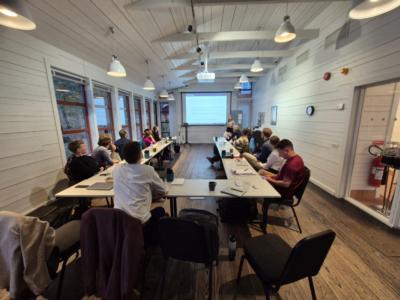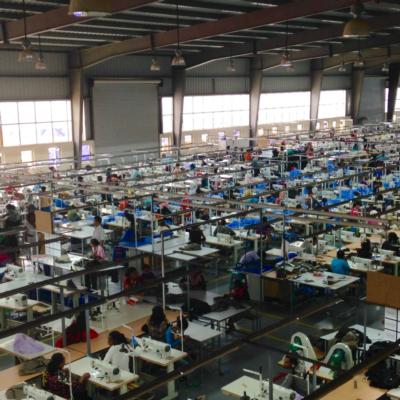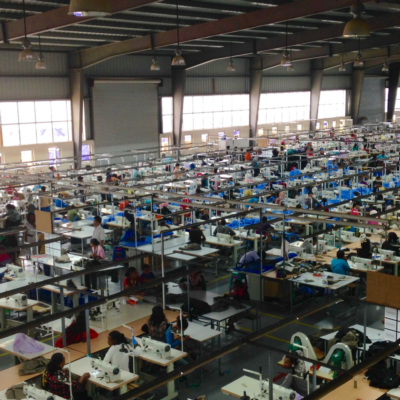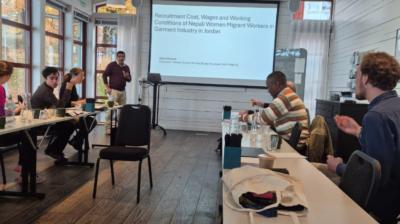Creating jobs, developing skills
A permanent job with a decent salary is an effective way out of poverty. How to boost growth in the labour market should thus be an essential question for policy makers.
Existing research and knowledge can help policy makers in choosing the best way forward. In close cooperation with our partners in Ethiopia, Nepal, and Tanzania, we have created this platform to highlight important policy challenges and show how research best can be utilised to solve them.
The network focuses on three types of policy issues:
Creation of new jobs
- What is the government and donor role in job creation?
- How can a country secure a balanced transition out of agriculture?
- Balanced growth in both urban and rural areas
- Inclusive growth with permanent jobs also for low-skilled workers
- Impact of labor market programs
- How does getting a job change people's life?
Well functioning labor markets
- Access to jobs for the poor and marginalized, including women
- Minimize the economic and social costs of labor migration
Improved competence for workers
- How can the productivity of subsistence farmers be improved?
- How can the incomes of labor migrants be improved?
- What are the effects of different types of skill training and supplemental programs?
Latest
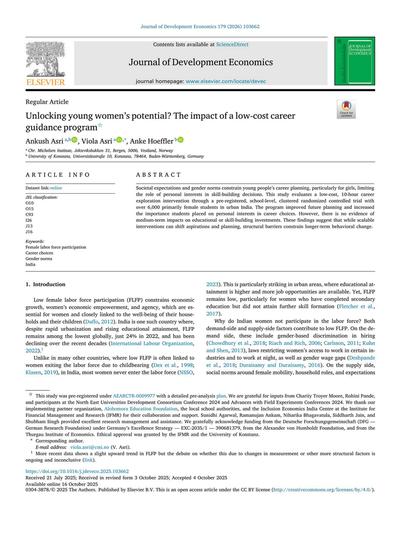
Unlocking young women’s potential? The impact of a low-cost career guidance program
News

Building Futures through Childcare: Insights from the Early Child Care and Education Workshop
Activities

Workshop at Norad: Early Childhood Care and Education in Developing Countries

Value chain interventions and women's economic empowerment – background and evidence

Norad: Women in private sector development and sustainable job creation

Norad: Youth economic empowerment interventions in developing countries

Kathmandu: Labor markets in poor countries: Interventions in support of decent work in the formal and informal sectors

Norad: Labor markets in poor countries: Interventions in support of decent work in the formal and informal sectors
Publications

Unlocking young women’s potential? The impact of a low-cost career guidance program
Sand Mining, Non‐Farm Employment and a Local Labour Force in Rural Bangladesh
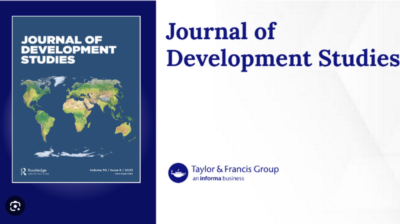
Effects of jobs on ethnic switching – Evidence from a field experiment in Ethiopia

Jobs and Political Participation: Evidence from a Field Experiment in Ethiopia

Jobs and intimate partner violence. Evidence from a field experiment in Ethiopia

Back in business: Private sector development for poverty reduction in Norwegian aid

Business training in Tanzania: From research driven experiment to local implementation
Partners

Research on Poverty Alleviation (REPOA)
Description of REPOA and their role in the project.
External resources
There is an active research field into jobs in developing countries. Below are summaries and links to several interesting papers by researchers from other institutions that might be of interest.
Soft skills
Returns to On-the-job Soft Skills Training (2023)
Journal of Political Economy
The paper estimates productivity gains from a soft skills training at the workplace among Indian garnment workers.The estimated gains are 13.5% on average with greater gains among trainees who work together and untreated coworkers benefitting indirectly. Despite these productivity gains, the results do not show significant effects on wages or retentions due to existing labor market frictions.
Business training evaluations
What Are We Learning from Business Training and Entrepreneurship Evaluations around the Developing World? (2014)
The World Bank Research Observer
This is a critical review of business training evaluations which in summary reports on most evaluations suffering from small sample sizes, a focus on short-term impact measurements as well as methodological limitations such as survey attrition. Even in the short-term the impacts on business survival rates are modest but several business training programs help prospective entrepreneurs to start their own businesses. Finally, trainees adopt some of the taught practices but there is little impact on profits or sales. Overall, there is only limited evidence to guide policymakers as it is unclear whether any observed effects are due to productivity gains or from drawing sales from competing businesses.
Active Labor Market Policies
How Effective Are Active Labor Market Policies in Developing Countries? A Critical Review of Recent Evidence (2017)
The World Bank Research Observer
This article reviews the evidence of the effectiveness for a variety of Active Labor Market Policies in developing countries incl. vocational training, wage subsidies and search and matching assistance. Despite of the positive theoretical expectations, many evaluations find no significant impacts on employment or earnings potentially due to fewer market failures in urban labor markets than expected. The authors therefore also present examples which seem to be more promising.
Managers and work quality
Managerial Quality and Productivity Dynamics (2023)
This articles examines the correlates of managerial characteristics with productivity using survey data on managers as well as detailed production data. The most relevant factor seem to be managerial attention and control. Managerial practices seem to enable faster learning-by-doing.
Low productivity in developing countries
Why Do Firms in Developing Countries Have Low Productivity? (2010)
American Economic Review: Papers & Proceedings
This paper examines why firms in developing countries have relatively lower productivity and the authors focus on management practices, delegation of decision making and financial constraints. The authors find that firms in developing countries tend to be badly managed that financial constraints limit firms' growth and that delegation of decisionmaking is very limited because owners fear that managers may steal from them.
Improved management and productivity
Does Management Matter? Evidence from India (2013)
The Quarterly Journal of Economics
With a management field experiment, the authors examine whether differences in management practices can explain differences in productivity. The treatment consists of offering free management consulting services. Adoption of management practices raises productivity through improved quality, efficiency, reducing inventory and in the long run allowed firms to open more production plants. Profitable practices were apparently now adopted earlier as firms faced information constraints. Finally, barriers to market entry were relatively high and thereby relatively badly managed firms were able to survive.
Differences in management
What Drives Differences in Management Practices? (2019)
American Economic Review
This paper examines the variation of management practices and the authors find that 40% of the variation in management practices stems from different plants within the same firm. Further, management practices explain about 20% of the variation in productivity. Thereby management practices are as relevant as human capital for example or even more relevant. Both business environment and learning from extremely productive plants can improve management practices of existing firms.
Trainings for small businesses
Small Business Training to Improve Management Practices in Developing Countries: Reassessing the Evidence for "Training Doesn't Work" (2021)
Oxford Review of Economic Policy
Earlier randomized controlled trials were unable to detect impacts of business trainings on profits or sales. This articles considers more recent evidence and shows that business trainings can increase profits and sales by 5-10 percent. While this corresponds to optimistic expectations, most of the field experiments do not have the statistical power to detect such changes. The review then proposes how business trainings can be designed more effectively and discusses scenarios in which programs can be scaled up effectively.
Long-run effects of management training
Do Management Interventions Last? Evidence from India (2020)
American Economic Journal: Applied Economics
This articles examines the impacts of a randomized intervention offering consulting on management practices after 9 years. Of the initially adopted management practices about 50% were still practiced in the treatment group plants and not in the control group plants. Several practices spread within firms but not across firms. The most commonly stated reasons for dropping certain practices included managerial turnover and lack of director time.
Meta-analysis of small business trainings
The Impact of Business Support Services for Small and Medium Enterprises on Firm Performance in Low- and Middle-income Countries (2016)
Campbell Systematic reviews
This is a systematic review of 40 rigorous evaluations of business-support interventions that target small and medium enterprises. The authors find that business-support interventions improve firm performances and create jobs but there is still lack of evidence on which interventions work best and why requiring more rigorous impact evaluations.
Randomly giving people a job
The Impacts of Industrial and Entrepreneurial Work on Income and Health: Experimental Evidence from Ethiopia (2018)
American Economic Journal: Applied Economics
This paper examines the impact of being offered an industrial job compared to a startup grant plus entrepreneurial training compared to a pure control. The job offer doubles exposure to industrial work but most worker quit within a few months. Therefor it does not have any impact on employment or earnings. The applicants accepted the job to cope with temportary adverse shocks but at the same time the industrial work exposure led to health problems. With the business grant plus training, applicants preferred entrepreneurship compared to industrial labor.
Labor turnover in Ethiopia
Understanding the Challenges of High Labor Turnover in the Ethiopian Manufacturing Industry (2020)
This paper examines the main reasons for high turnover rates and finds unrealistic expectations, poor working conditions, difficulties combining domestic responsibilities and factory employment as the main reasons. Especially low wages and poor working conditions lead to high turnover which may affect competition in global markets as well as economic development from industrialization.
Jobs and political participation
Jobs and Political Participation: Evidence from a Field Experiment in Ethiopia (2024)
The Journal of Politics
We identify the effects of employment on political participation by collaborating with 27 large companies in Ethiopia to randomly assign jobs to equally qualified female applicants. The job offers increase formal employment and earnings, but we can clearly reject any positive effects on political participation. We find no effects on political interest, raising issues, or protest activity, and we find negative effects on participation in community meetings. We further find that job offers reduce internal and external political efficacy, suggesting that employment may actually be politically disempowering. Our qualitative data suggest that several features of the jobs may contribute to lower political efficacy directly.
Social skills in the labor market
The Growing Importance of Social Skills in the Labor Market (2017)
The Quarterly Journal of Economics
This paper shows that social skills are increasingly rewarded in the US labor market as the share of jobs with human interactions grew and the share of less social jobs reduced. In particular jobs requiring math skills as well as social skills had high employment and wage growth. To gain a better understanding of these patterns, the paper also provides a theoretical model. Social skills can be essential to reduce coordination costs, allows workers to specialize and can make team work more efficient.
Soft skills in Jamaican small businesses
The Impact of Soft-Skills Training for Entrepreneurs in Jamaica (2022)
World Development
This paper examines the effectiveness of two soft skills training programs targeting Jamaican entrepreneurs and documents short-run impacts on business outcomes but no significant impacts after one year. Further, the authors do not find any impacts for women and no impacts for a training that combines soft and hard skills. The soft skills training persistently improves both self-reported as well as incentivized measures of soft skills.
Making transformational entrepreneurs
Making Entrepreneurs: Returns to Training Youth in Hard Versus Soft Business Skills (2021)
This paper studies the impact of the Skills for Effective Development (SEED) program which can be compared to an in-residence mini-MBA with a training that lasts three weeks. The program contained two treatments - hard-skills MBA with 75% hard skills and 25% soft skills and a soft-skills MBA with the reverse mix. After 3.5 yeard the results indicate that the training increased both hard and soft skills but only the soft skills could be linked to improved self-efficacy, persuation and negotiation. Improved skills also led to higher earnings primarily through self-employment, increased rate in starting a business and several other improved business outcomes including job creation. Given these positive impacts, both types of the program were cost-effective.
Labor rationing
Labor Rationing (2021)
American Economic Review
This paper examines experimentally the impacts of randomly hiring large shares of laborers in Indian villages in external month-long jobs outside the rural labor market. This external hiring shock increases wages and reduces local employment rates during time periods right before or after the main harvest seasons. During lean periods, wages and employment do not changes but workers who are not hired are more likely to be employed in the external month-long work program. Many of those workers would have otherwise taken up self-employment but are better off when hired through the work program.
Efficient corruption for jobs
Jobs for Sale: Corruption and Misallocation in Hiring (2021)
American Economic Review
This paper examines the impacts of corrupt hiring for government jobs. Those who get hires pay on average a bribe corresponding to 17 monthly salaries but against what one would expect the hires are of the same quality as those who were hired based on mired. As jobs differ, correlations between wealth and quality of applicants can be positive and negative. However, in the setting examined the correlation was positive leading to relatively good performance of hires.
What constrains the growth of small firms?
Experiments and Entrepreneurship in Developing Countries (2019)
Annual Review of Economics
This paper reviews experimental studies that examine the constraints on the growth of firms. Studies have shown that especially smaller firms face capital constraints and it is crucial to alleviate such capacity constraints. While urban labor markets for laborer with lower skill levels work reasonably well, labor markets for high-skilled laborers have frictions which affect firms. Managerial training delivered to small firms tends not to be effective. Demand shocks can effectively generate firm growth. Studies are most valuable when they are based on theories and complement existing evidence.
Giving firms an extra worker
Labor Drops: Experimental Evidence on the Return to Additional Labor in Microenterprises (2019)
American Economic Journal: Applied Economics
This paper examines the impact of a wage subsidy provided to small enterprises in Sri Lanka. The results show that firms increased employment during the subsidy period of 12 months and the wage subsidy increased business survival. However, there was no long-term impact on employment after the subsidy period. Further, profits and sales remained unchanged both during and after the subsidy period.
Which part of multi-faceted programs work?
Unpacking a Multi-faceted Program to Build Sustainable Income for the Very Poor (2022)
Journal of Development Economics
Multi-faceted graduation programs have been very effective in lifting people out of poverty. These programs transfer productive assets, give regular training and coaching, regular cash transfers for consumption support and access to savings. Given their multifaceted nature, implementation costs are quite high. This paper therefore examines which components can lead to long-term effects and examine whether the asset transfer or the provision of a savings account with deposit collection could have similar effects to the multi-faceted program. The asset transfer on its own does not generate similar impacts, the savings account with deposit collection does have similar impacts but these are short-lived.
Compliance with minimum wage laws
Productivity, Non-compliance and the Minimum Wage (2022)
Journal of Development Economics
This paper examines compliance with minimum wages in developing countries, and develops a model to show why governments may tolerate non-compliance. Many small firms would not be able to survive if they were to comply with minimum wage laws. Therefore, governments have an incentive to tolerate non-compliance. Further, worker complaints are the main motivation for governments to inspect firms for non-compliance. The paper provides a theoretical model to rationalise these observations.
Determining the reservation wage
What do Jobseekers Want? Comparing Methods to Estimate Reservation Wages and the Value of Job Attributes (2022)
Journal of Development Economics
This paper aims to examine jobseekers' preferences including their reservation wage and how much they value non-wage amenities. The authors use four different methods for elicitation using a job-matching center and find that the Discrete Choice Experiments work best and can be useful to guide policymakers as well as employers to design policies and compensation bundles considering both the reservation wage and non-wage amenities.
Training microenterprises
Is there a Cost-effective Means of Training Microenterprises? (2020)
The World Bank Economic Review
As very few management training programs are cost-effective, this paper examines the cost-effectiveness of a mentorship program provided to Kenyan microentrepreneurs. The authors find that for each USD of spent on the program, the average profit increases by 1.63 USD. Compared to most other training programs, this program has a higher impact and a lower cost. The paper then discusses how the mentorship program performs better than standard classroom training to improve future interventions designed to increase managerial capacity.
Projects
Ongoing
Education for sustainable job creation (2020-2024)
Completed
Women in Transition: Female Employment and Political Empowerment during Ethiopia's Reform Process (2020-2023)
Women in the developmental state: female employment and empowerment (2015-2019)
UD(R) - Three evaluations of Norwegian development assistance to private sector development (2018-2019)
Ethiopian Flower Farm Employment Project (2008-2014)
Gender of children, education and occupational choice in Nepal (2010-2014)
Long term poverty dynamics in Nepal (2010-2013)
Inclusive growth in India (2009-2012)
Poverty traps in industries with low knowledge- and investment barriers (2009-2010)
Social networks and labour migration in South-Asia (2008-2010)
Bonded Labor in Nepal (2004-2006)

